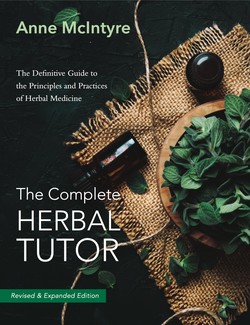Читать книгу The Complete Herbal Tutor - Anne Mcintyre - Страница 22
На сайте Литреса книга снята с продажи.
ОглавлениеRe-evaluating Herbal Medicines
Modern evaluation of herbal medicines is divided between “rationalistic/scientific” and “energetic” viewpoints. With the emergence of modern Western scientific medicine, herbs have been seen either as old fashioned and obsolete or as sources of pharmacological constituents to be used as building blocks for making drugs.
For thousands of years, until the last 200 years or so, plants provided the sole source of medicines and many familiar and potent medicines of the 21st century have been derived directly or indirectly from herbs. Despite this, there are still those who persist in the view that the value of herbs is unproven scientifically. Cinchona bark, for example, is the source of quinine, the anti malaria drug, periwinkle is the source of vincristine, the anti-tumour drug, the opium poppy is the source of morphine and codeine. Atropine, aspirin, digoxin and ephedrine are all plant derived drugs found in modern pharmacological textbooks and dispensaries. At the same time, however, the unquestionable value and popularity of herbs as medicines in the last 20-30 years has prompted an increasing amount of research into the action of plant components that is not only fascinating but also greatly helpful to the modern practitioner.
The bark from the Cinchona tree, native to South America, is the source of quinine in anti-malarial drugs.
Alongside this enquiry into the world of herbs has come a re-emergence in popularity of more ancient systems of medicine with their “energetic” or “holistic” philosophies, as well as more modern systems of healing using plants, such as aromatherapy and flower essences. This has occurred, amid a milieu of natural healing that has challenged modern allopathic medicine to the point that now many people are conscious that valid choices exist for the patient who is embarking on a course of treatment, particularly for addressing one or more chronic problems.
Whole Plant Medicines
To stand up to scrutiny in a modern scientific world, herbalists now have to provide evidence of the efficacy and safety of the therapeutic herbs they use and apply the tools of the scientific world, biochemistry and pharmacology, to their task. While herbalists advocate the use of whole plant medicines, their enquiry necessitates that, for study and evaluation purposes, ingredients are singled out and their actions are ascertained. Such research enables quality testing, identifies efficient extraction methods and provides pointers to potential side effects and herb-drug interactions. Once this is accomplished it does not, however, tell the whole story and the knowledge gained from such study needs still to be incorporated into a more overall view of the whole plant. It has long been held that a herb is more than the sum of its parts, and, despite investigations into what are seen as the active ingredients in a given plant, there are other “lesser” constituents that have an equally important role to play therapeutically. These play an essential role in determining how effective the primary healing agents will be by rendering the body more or less receptive to their powers. Some of these “synergistic” substances will make the active constituents more easily assimilated and readily available in the body, while others will buffer the action of other potent plant chemicals, thus preventing the risk of side effects. It is the natural combination of both types of substances that determines the healing power and safety of any herbal medicine.
Opium poppies in Tasmania, Australia; some 50% of the world's crop used in medicine is grown here.
Before the development of modern scientific methods for isolating active constituents, whole plant medicines were used. Then, as science progressed, many of these constituents were able to be synthesised in the laboratory, perhaps in the assumption that synthetic compounds were similar to those derived from the plant world and as such would be assimilated just as easily by the body, and herbs became more or less redundant. However, chemical analysis of medicinal plants has demonstrated that there is a similarity in the molecular structure of components of plants and the human body, which makes the foods we eat and the herbs we use as medicines easily assimilated. The isolation and synthesis of potent active ingredients can produce an array of side-effects. Plant-derived drugs such as morphine, digoxin, ephedrine and atropine clearly need to be used with great caution. Even aspirin carries its risks and after 1986 all children's aspirin based drugs were withdrawn from the market due to their implication in association with Reye's syndrome in children, which can cause damage to the kidneys and brain.
Vinca, or periwinkle, is now known to be the source of vincristine, the anti-tumour drug.
